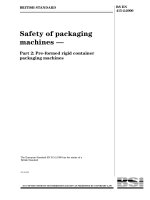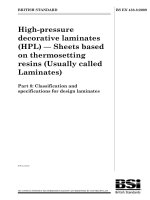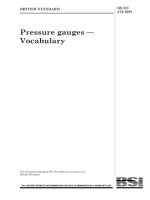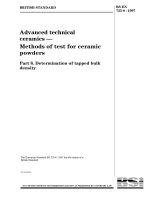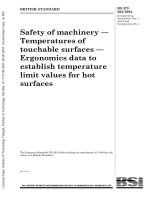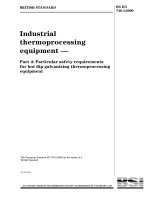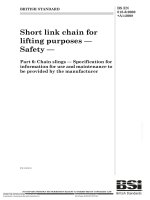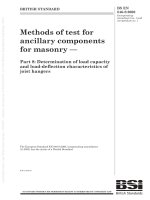Bsi bs en 00866 8 2000
Bạn đang xem bản rút gọn của tài liệu. Xem và tải ngay bản đầy đủ của tài liệu tại đây (107.97 KB, 10 trang )
BRITISH STANDARD
Biological systems for
testing sterilizers and
sterilization
processes Ð
Part 8: Particular requirements for
self-contained biological indicator
systems for use in ethylene oxide
sterilizers
The European Standard EN 866-8:1999 has the status of a
British Standard
ICS 11.080.10
NO COPYING WITHOUT BSI PERMISSION EXCEPT AS PERMITTED BY COPYRIGHT LAW
|
|
|
|
|
|
|
|
|
|
|
|
|
|
|
|
|
|
|
|
|
|
|
|
|
|
|
|
|
|
|
|
|
|
|
|
|
|
|
|
|
|
|
|
|
|
|
|
|
|
|
|
|
|
|
|
|
|
|
|
|
|
|
|
|
|
|
|
|
|
|
|
|
|
|
|
|
|
|
|
|
|
|
|
|
|
|
|
|
|
|
|
|
|
|
|
|
|
|
|
|
|
|
|
|
|
|
|
|
|
|
|
|
|
|
|
|
|
|
|
|
|
|
|
|
|
|
|
|
BS EN
866-8:2000
BS EN 866-8:2000
National foreword
This British Standard is the official English language version of EN 866-8:1999.
The UK participation in its preparation was entrusted by Technical Committee
LBI/35, Sterilizers, autocalves and distinfectors, to Subcommittee LBI/35/3,
Sterilization indicators, which has the responsibility to:
Ð aid enquirers to understand the text;
Ð present to the responsible European committee any enquiries on the
interpretation, or proposals for change, and keep the UK interests informed;
Ð monitor related international and European developments and promulgate
them in the UK.
A list of organizations represented on this subcommittee can be obtained on request
to its secretary.
Cross-references
The British Standards which implement international or European publications
referred to in this document may be found in the BSI Standards Catalogue under the
section entitled ªInternational Standards Correspondence Indexº, or by using the
ªFindº facility of the BSI Standards Electronic Catalogue.
A British Standard does not purport to include all the necessary provisions of a
contract. Users of British Standards are responsible for their correct application.
Compliance with a British Standard does not of itself confer immunity
from legal obligations.
Summary of pages
This document comprises a front cover, an inside front cover, the EN title page,
pages 2 to 7 and a back cover.
The BSI copyright notice displayed in this document indicates when the document
was last issued.
This British Standard, having
been prepared under the
direction of the Sector
Committee for Materials and
Chemicals, was published under
the authority of the Standards
Committee and comes into effect
on 15 June 2000
BSI 06-2000
ISBN 0 580 34604 8
Amendments issued since publication
Amd. No.
Date
Comments
EN 866-8
EUROPEAN STANDARD
NORME EUROPÊENNE
EUROPẰISCHE NORM
December 1999
ICS 11.080
English version
Biological systems for testing sterilizers and sterilization processes Ð
Part 8: Particular requirements for self-contained biological indicator
systems for use in ethylene oxide sterilizers
SysteÁmes biologiques pour l'essai des steÂrilisateurs
et les proceÂdeÂs de steÂrilisation Ð
Partie 8: Exigences particulieÁres pour les systeÁmes
autonomes d'indicateurs biologiques destineÂs aÁ eÃtre
utiliseÂs dans des steÂrilisateurs aÁ l'oxyde d'eÂthyleÁne
Biologische Systeme fuÈr die PruÈfung von
Sterilisatoren und Sterilisationsverfahren Ð Teil 8:
Spezielle Anforderungen an Bio-Indikator-Einheiten
fuÈr den Gebrauch in Ethylenoxid-Sterilisatoren
This European Standard was approved by CEN on 25 November 1999.
CEN members are bound to comply with the CEN/CENELEC Internal Regulations
which stipulate the conditions for giving this European Standard the status of a
national standard without any alteration. Up-to-date lists and bibliographical
references concerning such national standards may be obtained on application to
the Central Secretariat or to any CEN member.
This European Standard exists in three official versions (English, French, German).
A version in any other language made by translation under the responsibility of a
CEN member into its own language and notified to the Central Secretariat has the
same status as the official versions.
CEN members are the national standards bodies of Austria, Belgium,
Czech Republic, Denmark, Finland, France, Germany, Greece, Iceland, Ireland, Italy,
Luxembourg, Netherlands, Norway, Portugal, Spain, Sweden, Switzerland
and United Kingdom.
CEN
European Committee for Standardization
Comite EuropeÂen de Normalisation
EuropaÈisches Komitee fuÈr Normung
Central Secretariat: rue de Stassart 36, B-1050 Brussels
1999 CEN All rights of exploitation in any form and by any means reserved worldwide for CEN national
Members.
Ref. No. EN 866-8:1999 E
Page 2
EN 866-8:1999
Foreword
This European Standard has been prepared by
Technical Committee CEN/TC 102, Sterilizers for
medical purposes, the Secretariat of which is held
by DIN.
EN 866 consists of the following parts under the
general title Biological systems for testing sterilizers
and sterilization processes:
Part 1: General requirements;
Part 2: Particular systems for use in ethylene oxide
sterilizers;
Part 3: Particular systems for use in moist heat
sterilizers;
Part 4: Particular systems for use in irradiation
sterilizers;
Part 5: Particular systems for use in low
temperature steam and formaldehyde sterilizers;
Part 6: Particular systems for use in dry heat
sterilizers;
Part 7: Particular requirements for self-contained
systems for use in moist heat sterilizers;
Part 8: Particular requirements for self-contained
systems for use in ethylene oxide sterilizers.
In addition CEN/TC 102 Working Group 7 has prepared
EN 867 consisting of the following parts under the
general title Non-biological systems for use in
sterilizers:
Part 1: General requirements;
Part 2: Process indicators (Class A);
Part 3: Specification for Class B indicators for use
in the Bowie and Dick Test;
Part 4: Specification for indicators as an alternative
to the Bowie and Dick test for the detection of steam
penetration (in preparation);
Part 5: Specification for indicator systems and
process challenge devices for use in performance
testing for small sterilizers Type B and Type S
(in preparation).
This European Standard shall be given the status of a
national standard, either by publication of an identical
text or by endorsement, at the latest by June 2000, and
conflicting national standards shall be withdrawn at
the latest by June 2000.
According to the CEN/CENELEC Internal Regulations,
the national standards organizations of the following
countries are bound to implement this European
Standard: Austria, Belgium, Czech Republic, Denmark,
Finland, France, Germany, Greece, Iceland, Ireland,
Italy, Luxembourg, Netherlands, Norway, Portugal,
Spain, Sweden, Switzerland and the United Kingdom.
Contents
Foreword
Introduction
1
Scope
2
Normative references
3
Definitions
4
General requirements
5
Test organisms
6
Population of test organisms
7
Carriers
8
Materials of construction
9
Resistance
Annex A (normative) Determination of
growth inhibition by component materials,
dimensional stability and the suitability of
growth medium
Annex B (normative) Determination of
resistance to ethylene oxide sterilization
Page
2
3
3
3
3
3
3
4
4
4
5
5
6
BSI 06-2000
Page 3
EN 866-8:1999
Introduction
2 Normative references
This European Standard specifies the performance
requirements for self-contained biological indicators
supplied ready for use. These systems are intended
primarily for use as routine monitors. When it is
intended to use self-contained biological indicators in
routine monitoring, the chosen indicator system should
be employed along with any other chosen indicator
system during the process development and validation
stages. EN 866-2 specifies the performance
requirements for biological indicators supplied ready
for use and for suspensions of test organisms supplied
either for the preparation of biological indicators or for
the inoculation of product for use in validation studies
on, and routine monitoring of, ethylene oxide
sterilization processes.
The use of the indicators specified in this standard are
described in EN 550.
The biological indicators specified in this standard are
not intended for use in any process other than
ethylene oxide sterilization. The use of a biological
indicator in a process other than that stated by the
manufacturer can give dangerously misleading results.
The use of a biological system for testing a sterilization
process does not imply that the system will respond
equally to inadequate levels of all the critical variables
of the process.
The performance of a biological indicator can be
affected by the conditions of storage prior to use, the
methods of use, and the techniques employed after
exposure to the process. For these reasons, the
recommendations of the manufacturer for storage and
use should be followed and biological indicators
should be transferred to the specified recovery
conditions as soon as possible after exposure to the
process. Biological indicators should not be used
beyond any expiry date stated by the manufacturer.
Biological indicators should always be used in
combination with a physical and/or chemical
monitoring in demonstrating the efficacy of a sterilizing
process. When a physico-chemical variable of a
sterilizing process is outside its specified limits, a
sterilization cycle should always be regarded as
unsatisfactory (see also EN 550), irrespective of the
results obtained from the biological indicators.
This European Standard incorporates by dated or
undated reference, provisions from other publications.
These normative references are cited at the
appropriate places in the text and the publications are
listed hereafter. For dated references, subsequent
amendments to or revisions of any of these
publications apply to this European Standard only
when incorporated in it by amendment or revision.
For undated references the latest edition of the
publication referred to applies.
EN 866-1:1997, Biological systems for testing
sterilizers and sterilization processes Ð
Part 1: General requirements.
1 Scope
This part of EN 866 specifies requirements for
self-contained biological indicator systems intended for
use in the routine monitoring of the performance of
sterilizers employing ethylene oxide gas as the
sterilant. These are intended for use in sterilizers
employing pure ethylene oxide or admixtures of the
gas with diluent gases, over a sterilizing temperature
range of 20 8C to 65 8C.
NOTE 1 EN 1422 specifies the performance and test requirements
for ethylene oxide sterilizers.
NOTE 2 EN 550 specifies, inter alia, the requirements for routine
monitoring of ethylene oxide sterilization.
BSI 06-2000
3 Definitions
For the purposes of this European Standard, the
definitions given in EN 866-1 apply, together with the
following.
3.1
self-contained biological indicator system
an inoculated carrier presented in a primary pack
which also contains the growth medium required for
recovery
3.2
survival-kill window
the extent of exposure to a sterilization process under
defined conditions when there is a transition from all
biological indicators showing growth (survival exposure)
to no biological indicators showing growth (kill
exposure)
NOTE The survival-kill window is calculated by the following
formula.
Survival exposure $ (log10 (nominal population) 2 2) 3 D value
Kill exposure $ (log10 (nominal population) + 4) 3 D value
The units for both survival and kill exposures will be the same as
the units used for the D value, i.e. minutes.
4 General requirements
The requirements of EN 866-1:1997 shall apply except
for 4.4, clause 8 and clause 10.
5 Test organisms
The test organism shall be spores of Bacillus subtilis
var. niger or other strains or organisms of
demonstrated equivalent performance as required by
this European standard.
NOTE Bacillus subtilis var. niger NCTC 10073, ATCC 9372,
DSM 2277, DSM 675 and CIP 77.18 have been found to be suitable.
Page 4
EN 866-8:1999
6 Population of test organisms
8 Materials of construction
6.1 Replicate determinations of the viable count on
the same batch of suspension used to prepare the
biological indicators shall be within ±35 % of the
nominal population.
8.1 The materials of which the self-contained
biological indicator system is made shall withstand
exposure to the sterilization process for which it is
intended without distortion, melting, corrosion or other
failure which would impair its utility.
Compliance shall be tested by observation of the
assembled materials exposed to the following
conditions:
6.2 The number of recoverable test organisms in each
biological indicator shall be controlled during
manufacture to be either within ±50 % of the nominal
population stated by the manufacturer or within the
minimum and maximum populations stated by the
manufacturer.
6.3 Retrospective determination of the count shall be
made by performing a viable count under the culture
conditions on a suspension of test organisms obtained
by physical removal of the test organisms from the
carrier through ultrasonication, shaking with glass
beads, or other appropriate, validated methods. Counts
obtained shall be regarded as acceptable if they are
within 250 % and +300 % of the nominal population
stated by the manufacturer or the midpoint between
the minimum and maximum populations stated by the
manufacturer.
NOTE The method specified by the manufacturer for the removal
of test organisms from the carrier should be used.
6.4 The nominal number of spores shall not be less
than 1 3 106 per unit and shall be stated in increments
not greater than 0,1 3 106.
7 Carriers
7.1 The suitability of the carrier for use in ethylene
oxide sterilization processes shall be demonstrated in
accordance with the requirements given in 6.1, 6.2 and
annex A of EN 866-1:1997.
7.2 The conditions to be used to establish compliance
shall be:
Ð
Ð
Ð
Ð
Temperature
Relative humidity
Gas concentration
Exposure time
$
$
$
$
55 8C
70 %
800 mg/l
6h
NOTE These conditions have been selected to represent a
realistic, but severe, challenge to the carrier whilst remaining
within the practical limits of an ethylene oxide sterilization
process.
Ð Temperature
Ð Relative humidity
Ð Gas concentration
Ð Exposure time
$
$
$
$
55 8C
70 %
800 mg/l
6h
NOTE 1 The self-contained biological system should be
sufficiently robust to withstand transport in the secondary pack
and handling at the point of use without breakage.
NOTE 2 The design of the self-contained biological indicator
system should be such that:
a) it will minimize the loss of the original inoculum of test
organisms during transport and handling; and
b) it is appropriate to be located in a process challenge device
without impairing the function of the process challenge device.
Compliance shall be tested in accordance with the
method described in annex A.
8.2 The utility of the growth medium shall not be
impaired by exposure to the sterilization process.
Compliance shall be tested by observation of the
assembled materials before and after exposure to the
following conditions:
Ð Temperature
Ð Relative humidity
Ð Gas concentration
Ð Exposure time
$
$
$
$
55 8C
70 %
800 mg/l
6h
Compliance shall be tested in accordance with the
method described in annex A.
8.3 During or after the sterilization process the
materials of which the self-contained biological
indicator system is made shall neither retain nor
release any substance to such an extent that there will
be inhibition of the growth of low numbers of
surviving test organisms under the culture conditions.
Compliance shall be tested in accordance with the
method described in A.2.1.
BSI 06-2000
Page 5
EN 866-8:1999
9 Resistance
9.1 The manufacturer shall state the survival-kill
window of each batch of self-contained biological
indicator systems in minutes to one decimal place and
the nominal temperature at which it was determined
(i.e. 30 8C or 54 8C). The manufacturer shall state the
accuracy with which the survival-kill window value
was determined (e.g. ±0,5 min). This accuracy shall not
exceed ±1,0 min.
9.2 The manufacturer shall obtain a D value either by
the survivor curve method or by the MPN method
(see annex B of EN 866-1:1997) for the spore
population in the biological indicators when exposed
to (600 ± 30) mg/l ethylene oxide at (30 ± 1) 8C
and (60 ± 10) % relative humidity or to (600 ± 30) mg/l
ethylene oxide at (54 ± 1) 8C and (60 ± 10) % relative
humidity. The D value shall be not less than 12,5 min
under the conditions at 30 8C and/or not less
than 2,5 min under the conditions and 54 8C. This shall
be determined in accordance with the method given in
annex A or a method of demonstrated equivalence.
9.3 The D value of the spores in the self-contained
biological indicator system determined in 9.2 and the
nominal number of spores determined in 6.4 shall be
used to calculate the survival and kill exposures in
accordance with the equation in 3.2 (NOTE).
9.4 Either:
a) the survival exposures shall not be less
than 50 min and not greater than 120 min and the
kill exposure shall be not less than 125 min and not
greater than 300 min when determined at
(600 ± 30) mg/l ethylene oxide at (30 ± 1) 8C and
(60 ± 10) % relative humidity, in accordance with the
method in annex B.
or
b) the survival exposures in the self-contained
biological indicator system shall be not less
than 10 min and not greater than 21 min and the kill
exposure in the self-contained biological indicator
system shall be not less than 25 min and not greater
than 53 min when determined at (600 ± 30) mg/l
ethylene oxide at (54 ± 1) 8C and (60 ± 10) % relative
humidity, in accordance with the method in annex B.
Fifty replicates shall be used to confirm both the
survival exposure and the kill exposure.
9.5 When both of the reference methods given in
annex B of EN 866-1:1997 have been used, e.g. during
third party verification, the D value obtained by the
two methods shall be such that the higher value
obtained does not exceed the lower value by more
than 50 % of the lower value.
BSI 06-2000
Annex A (normative)
Determination of growth inhibition by
component materials, dimensional
stability and the suitability of growth
medium
A.1 Equipment and materials
A.1.1 Suspension of test organisms, of the same
strains and prepared in the same manner as the
organisms to be used for inoculation of carriers. The
suspension shall be of known population, determined
by viable count, to permit dispensing of aliquots with a
population of between 10 and 100 viable organisms.
This aliquot should have a volume not exceeding 10 %
of the volume of growth medium recommended by the
manufacturer.
A.1.2 Resistometer complying with the resistometer
described in annex B.
A.1.3 Growth medium of the same type and in the
same volume as stated for the recovery of the
biological indicator in normal use.
A.1.4 Incubator, set to the temperature stated for the
recovery of the biological indicator in normal use.
A.2 Determination of growth inhibition of
materials of construction
A.2.1 Procedure
A.2.1.1 Take a representative sample of twelve
uninoculated carriers and divide it into six lots of two.
A.2.1.2 Determine the maximum surface area of the
container (primary pack) and the growth medium
container which will be in contact with the growth
medium at the start of incubation (the contact area).
Take sufficient pieces of material from which the
primary pack and the growth medium container are
constructed (the container sample) to provide a total
surface area equivalent to twice the contact area.
These pieces shall be of such a size that they will be
completely covered by the volume of growth medium
used. No allowance shall be made for the increase in
contact area with the primary pack.
A.2.1.3 Place each of the two carriers of each of
three of these lots in a primary container together with
the container sample and then expose them to the
sterilization process.
A.2.1.4 Set the operational conditions of the
resistometer to the required conditions for the carrier
studies (see 7.2).
A.2.1.5 After exposure to the process, as soon as
possible but in any case within 30 min of the end of
the process, aseptically transfer an aliquot of the
untreated growth medium to each container. Care shall
be taken to ensure that all the container samples are
covered by the growth medium.
Page 6
EN 866-8:1999
A.2.1.6 Record the time taken to complete the
transfer.
A.2.1.7 Incubate the growth medium at the stated
temperature for 2 h, remove it from the incubator and
inoculate it with a volume of the test organism
suspension calculated to contain between 10 and 100
viable organisms. Return the inoculated media to the
incubator and incubate it for the time stated by the
manufacturer for the recovery of biological indicators
under the normal conditions of use.
A.2.1.8 For the negative control, transfer two carriers
and a container sample, not exposed to the process, to
each of the three containers containing the normal
atiquot of growth medium, incubate them for 2 h,
inoculate them with 10 to 100 test organisms, and
incubate them for the stated recovery period in the
same manner as described above.
A.2.1.9 For the positive control, incubator three
containers, each containing the normal aliquot of
growth medium but containing no carriers or container
samples, for 2 h, inoculate them with 10 to 100 test
organisms and incubate them for the stated recovery
period in the same manner as described above.
A.2.1.10 At the end of the stated recovery period
remove all nine containers from the incubator and
examine them for viable organisms in accordance with
the manufacturer's instructions.
A.2.1.11 Report the results as ªgrowthº
or ªno growthº of the test organism.
A.2.2 Interpretation of results
A.2.2.1 If ªno growthº occurs in one or more of the
positive controls the test procedure shall not be
regarded as valid.
NOTE No growth in the positive control can be indicative of
failure to control the population of the test organism inoculum, or,
of inappropriate recovery conditions
(growth medium, temperature etc.).
A.2.2.2 If ªno growthº occurs in one or more of the
negative controls the test procedure shall not be
regarded as valid.
NOTE No growth in the negative control, but growth in the
positive control can indicate that the material of which the carrier
is made is itself inhibitory to the growth of the test organism.
A.3 Dimensional and growth medium stability
A.3.1 Expose five self-contained biological indicator
systems (with no test organisms present) from each of
the three batches in a resistometer as described in
annex B to the conditions specified for the evaluation
of carriers in 7.2.
A.3.2 At the end of the exposure period measure and
visually examine each sample to determine whether
the external dimensions remain within the tolerances
specified by the manufacturer (see 6.3
of EN 866-1:1997) and that no distortion or other
failures which could compromise the utility of the
device has occurred.
A.3.3 Following this examination, release the growth
medium into the container in the manner defined by
the manufacturer and then inoculate it with a volume
of the test organism suspension calculated to contain
between 10 and 100 viable organisms. Transfer this
inoculated media to the incubator and incubate it for
the time stated by the manufacturer for the recovery of
biological indicators under normal conditions for use.
A.3.4 After incubation for the period recommended
by the manufacturer, remove the containers from the
incubator and examine them for growth by the method
described by the manufacturer.
If any one of the five samples in each batch show no
growth this shall be regarded as a failure in growth
medium stability for that batch.
If there are samples from two or more batches
showing no growth this shall be regarded as a failure
in growth medium stability.
Annex B (normative)
Determination of resistance to ethylene
oxide sterilization
B.1 Apparatus: Ethylene oxide biological
indicator resistometer
B.1.1 The equipment shall be capable of maintaining
the conditions given in Table B.1 within the limits
given for the exposure periods between 1 min
and 120 min to an accuracy of ±10 s and also shall run
for not less than 6 h.
A.2.2.3 If ªno growthº occurs in one or more of the
three tests on carriers exposed to the process the
carrier shall not be regarded as suitable for the
manufacture of inoculated carriers or biological
indicators.
NOTE No growth can be caused either by high levels of
adsorption/absorption of sterilant or by degradative changes in the
material of the carrier during the process.
BSI 06-2000
Page 7
EN 866-8:1999
Table B.1 Ð Conditions
Variable
Ethylene oxide
Temperature
Relative humidity
Vacuum
For resistance studies see clause 8
(600 ± 30) mg/l
(30 ± 1) 8C or (54 ± 1) 8C
(60 ± 10) %
for carrier studies see clause 7
not less than 800 mg/l
not less than 55 8C
not less than 70 %
# 5 kPa
NOTE Forced circulation can be required to maintain conditions
in the resistometer chamber within specified limits. Resistometers
intended for use with mixtures of ethylene oxide and inert gases
can be required to withstand high internal pressure, e.g. 650 kPa.
B.2.3 Place the loaded sample holder in the chamber,
close the chamber and leave for the time required to
allow the temperature to stabilize.
B.1.2 The equipment shall be provided with means to
evacuate the reaction chamber to less than 10 kPa
within 2 min to permit adequate air removal prior to
admission of the sterilant and to exhaust the sterilant
at the end of the exposure period.
B.2.4 Carry out the following sequence of operations
under automatic control:
a) evacuate the chamber to (10 ± 0,4) kPa;
b) admit sufficient water vapour to raise the relative
humidity in the chamber to (60 ± 10) %. Maintain
these conditions for a period of 20 min to 30 min;
c) admit ethylene oxide to the chamber to obtain a
concentration of (600 ± 30) mg/l within 60 s;
d) for the 0 minute exposure time no ethylene oxide
shall be admitted;
e) maintain these conditions for the required
exposure period;
f) at the end of the exposure period evacuate the
chamber to (10 ± 0,4) kPa within 60 s and then
admit filtered air, or inert gas such as nitrogen, to
ambient pressure;
g) repeat stage f) a further four times.
B.1.3 Air admitted at the end of the cycle shall be
filtered through a filter having the ability to remove not
less than 99,9 % of 0,5 mm particles.
B.1.4 The time to achieve the required gas
concentration from commencement of gas admission
shall not exceed 60 s and the time to exhaust the gas
to 10 kPa at the end of the exposure period shall not
exceed 60 s.
B.1.5 The chamber and door shall be provided with
means to maintain the temperature of the inner
surfaces of the chamber at the required operating
temperature.
B.1.6 The supply of ethylene oxide gas to the
chamber shall be filtered and pre-heated to ensure that
neither liquid ethylene oxide nor particles of polymer
are admitted to the chamber.
B.1.7 The equipment shall be capable of automatic
operation and shall be provided with a system for
recording temperature, pressure and humidity within
the chamber which is independent of the control
function and such that the limits of error on the
recording equipment do not exceed 50 % of the
tolerance allowed for each control variable.
NOTE For example the chamber temperature is required to be
controlled within ±1 K and thus the maximum allowable error
limit on the temperature recorder is ±0,5 K.
B.2 Procedure
B.2.1 Load the inoculated carriers onto a suitable
sample holder.
B.2.2 Pre-heat the resistometer chamber to the
chosen operating temperature.
BSI 06-2000
B.2.5 At the end of the above cycle remove the
sample holder from the chamber.
B.2.6 Within 2 h, or as otherwise specified by the
manufacturer, carry out any manipulations required to
bring the test organisms into contact with the recovery
medium and incubate in accordance with the
manufacturers instructions.
B.3 Verification of survival-kill window
B.3.1 Not less than 50 indicators exposed to the
specified conditions (see 9.2) for not more than the
time calculated from the D value for survival of all
biological indicators (see 3.2 and 9.3). All of the
indicators shall show growth when recovered
according to the manufacturers instructions.
B.3.2 Not less than 50 indicators exposed to the
specified conditions (see 9.2) for not less than the
time calculated from the D value for the kill of all
biological indicators (see 3.2 and 9.3). None of the
indicators shall growth when recovered according to
the manufacturer's instructions.
BS EN
866-8:2000
BSI
389 Chiswick High Road
London
W4 4AL
|
|
|
|
|
|
|
|
|
|
|
|
|
|
|
|
|
|
|
|
|
|
|
|
|
|
|
|
|
|
|
|
|
|
|
|
|
|
|
|
|
|
|
|
|
|
|
|
|
|
|
|
|
|
|
|
|
|
|
|
|
|
|
|
|
|
|
|
|
|
|
|
|
|
|
|
|
|
|
|
|
|
|
|
|
|
|
|
|
|
|
|
|
|
|
|
|
|
|
|
|
|
|
|
|
|
|
|
|
|
|
|
|
|
|
|
|
|
|
|
|
|
|
|
|
|
|
BSI Ð British Standards Institution
BSI is the independent national body responsible for preparing British Standards. It
presents the UK view on standards in Europe and at the international level. It is
incorporated by Royal Charter.
Revisions
British Standards are updated by amendment or revision. Users of British Standards
should make sure that they possess the latest amendments or editions.
It is the constant aim of BSI to improve the quality of our products and services. We
would be grateful if anyone finding an inaccuracy or ambiguity while using this
British Standard would inform the Secretary of the technical committee responsible,
the identity of which can be found on the inside front cover. Tel: 020 8996 9000.
Fax: 020 8996 7400.
BSI offers members an individual updating service called PLUS which ensures that
subscribers automatically receive the latest editions of standards.
Buying standards
Orders for all BSI, international and foreign standards publications should be
addressed to Customer Services. Tel: 020 8996 9001. Fax: 020 8996 7001.
In response to orders for international standards, it is BSI policy to supply the BSI
implementation of those that have been published as British Standards, unless
otherwise requested.
Information on standards
BSI provides a wide range of information on national, European and international
standards through its Library and its Technical Help to Exporters Service. Various
BSI electronic information services are also available which give details on all its
products and services. Contact the Information Centre. Tel: 020 8996 7111.
Fax: 020 8996 7048.
Subscribing members of BSI are kept up to date with standards developments and
receive substantial discounts on the purchase price of standards. For details of
these and other benefits contact Membership Administration. Tel: 020 8996 7002.
Fax: 020 8996 7001.
Copyright
Copyright subsists in all BSI publications. BSI also holds the copyright, in the UK, of
the publications of the international standardization bodies. Except as permitted
under the Copyright, Designs and Patents Act 1988 no extract may be reproduced,
stored in a retrieval system or transmitted in any form or by any means ± electronic,
photocopying, recording or otherwise ± without prior written permission from BSI.
This does not preclude the free use, in the course of implementing the standard, of
necessary details such as symbols, and size, type or grade designations. If these
details are to be used for any other purpose than implementation then the prior
written permission of BSI must be obtained.
If permission is granted, the terms may include royalty payments or a licensing
agreement. Details and advice can be obtained from the Copyright Manager.
Tel: 020 8996 7070.

